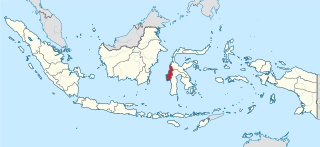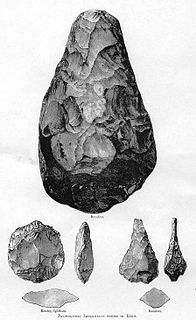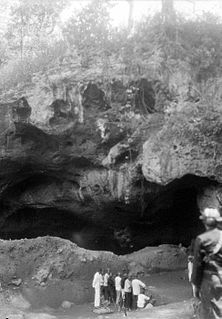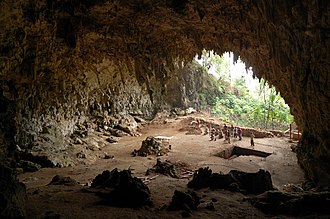
Sulawesi, also known as Celebes, is one of the four Greater Sunda Islands. It is governed by Indonesia. The world's eleventh-largest island, it is situated east of Borneo, west of the Maluku Islands, and south of Mindanao and the Sulu Archipelago. Within Indonesia, only Sumatra, Borneo and Papua are larger in territory, and only Java and Sumatra have larger populations.

Cave paintings are a type of parietal art, found on the wall or ceilings of caves. The term usually implies prehistoric origin, but cave paintings can also be of recent production: In the Gabarnmung cave of northern Australia, the oldest paintings certainly predate 28,000 years ago, while the most recent ones were made less than a century ago.

East Kalimantan is a province of Indonesia. Its territory comprises the eastern portion of Borneo. It had a population of about 3.03 million at the 2010 Census and 3.42 million at the 2015 Census; the latest official estimate is 3,721,389. Its capital is Samarinda.

West Sulawesi is a province of Indonesia. It is located in the western of the Sulawesi island. It covers an area of 16,937.16 km2, and its capital is Mamuju. The 2010 Census recorded a population of 1,158,651, while that in 2015 recorded 1,279,994; the latest official estimate is 1,536,115.

Figurative art, sometimes written as figurativism, describes artwork that is clearly derived from real object sources and so is, by definition, representational. The term is often in contrast to abstract art:
Since the arrival of abstract art the term figurative has been used to refer to any form of modern art that retains strong references to the real world.

Liang Bua is a limestone cave on the island of Flores, Indonesia. The cave is slightly north of the town of Ruteng in Manggarai Regency, East Nusa Tenggara.

The Celebes warty pig, also called Sulawesi warty pig or Sulawesi pig, is a species in the pig genus (Sus) that lives on Sulawesi in Indonesia. It survives in most habitats and can live in altitudes of up to 2,500 m (8,000 ft). It has been domesticated and introduced to a number of other islands in Indonesia.

The oldest undisputed examples of figurative art are known from Europe and from Sulawesi, Indonesia, dated about 35,000 years old . Together with religion and other cultural universals of contemporary human societies, the emergence of figurative art is a necessary attribute of full behavioral modernity.

The art of the Upper Paleolithic represents the oldest form of prehistoric art. Figurative art is present in Europe and Southeast Asia, beginning between about 40,000 to 35,000 years ago. Non-figurative cave paintings, consisting of hand stencils and simple geometric shapes, are somewhat older, at least 40,000 years old, and possibly as old as 64,000 years. This latter estimate is due to a controversial 2018 study based on uranium-thorium dating, which would imply Neanderthal authorship and qualify as art of the Middle Paleolithic.

Labuan Bajo is a fishing town located at the western end of the large island of Flores in the Nusa Tenggara region of east Indonesia. It is the capital of the West Manggarai Regency (Kabupaten Manggarai Barat), one of the eight regencies which are the major administrative divisions of Flores.

Bantimurung-Bulusaraung National Park is a national park in South Sulawesi in Indonesia. The park contains the Rammang-Rammang karst area, the second largest karst area known in the world after the one in South-Eastern China.
Prehistoric Indonesia is a prehistoric period in the Indonesian archipelago that spanned from the Pleistocene period to about the 4th century CE when the Kutai people produced the earliest known stone inscriptions in Indonesia. Unlike the clear distinction between prehistoric and historical periods in Europe and the Middle East, the division is muddled in Indonesia. This is mostly because Indonesia's geographical conditions as a vast archipelago caused some parts — especially the interiors of distant islands — to be virtually isolated from the rest of the world. West Java and coastal Eastern Borneo, for example, began their historical periods in the early 4th century, but megalithic culture still flourished and script was unknown in the rest of Indonesia, including in Nias, Batak, and Toraja. The Papuans on the Indonesian part of New Guinea island lived virtually in the Stone Age until their first contacts with modern world in the early 20th century. Even today living megalithic traditions still can be found on the island of Sumba and Nias.

Maros Regency is a regency of South Sulawesi province of Indonesia. It covers an area of 1,619.12 sq.km, and had a population of 319,002 at the 2010 Census and 338,917 at the Census of 2015. Almost all of the regency lies within the official metropolitan area of the city of Makassar. The capital town of the regency is Maros.

Pindul Cave is a cave formed by karst with underground river located about 7 kilometres south of the city centre Wonosari, Gunung Kidul. Gua Pindul is known for the cave tubing that visitors can do and is done with tires that float above the underground river inside the cave, this activity known as cave tubing. There are gaps above the cave that can be passed as a pathway to enter vertically.
Lokale Cave is a cave in Papua, Indonesia. The cave is in the village Lokale Woslimo, Baliem Valley, Jayawijaya, Papua.
Mirror stone cave is a cave or tunnel located in a rock hill in West Manggarai, Flores, East Nusa Tenggara, Indonesia, just a few kilometers to the east of the town of Labuan Bajo.

The caves in the Maros-Pangkep karst are situated in South Sulawesi, Indonesia, and contain paintings from the paleolithic considered to be the earliest figurative art in the world, dated to at least 43,900 years ago.

Gua Lowo is a cave which is located at Watuagung, Watulimo sub-district of Trenggalek Regency, East Java in Indonesia. Gua Lowo is Indonesian word, which means bat's cave. There are no other fauna except bats in this cave. The cave is about 5 kilometers long, though only 859 meters of the cave is accessible. Based on statements from cave experts, Mr. Gilbert Manthovani and Dr. Robert K Kho in 1984, Gua Lowo is the longest natural cave in Southeast Asia.

Lubang Jeriji Saléh is a limestone cave complex in the Sangkulirang-Mangkalihat Karst located in the remote jungle of Bengalon district in East Kutai, East Kalimantan province on Borneo island, Indonesia. In a 2018 publication a team of researchers announced to have found the then-oldest known work of figurative art in the world among the cave paintings, at 40,000 years old. However, the same team has since found and dated an elaborate therianthrope rock art panel in the Leang Bulu’ Sipong 4 cave in Sulawesi's Maros-Pangkep karst to around 44,000 years old, older than the figurative art in Lubang Jeriji Saléh.
Indonesian painting has a very long tradition and history in Indonesian art, though because of the climatic conditions very few early examples survive. The earliest Indonesian paintings were the rock paintings of prehistoric times, such as the petroglyphs found in places like in the caves in the district of Maros in Sulawesi, Indonesia. The Stone Age rock paintings found in the Maros cave are approximately 40.000 years old.


















